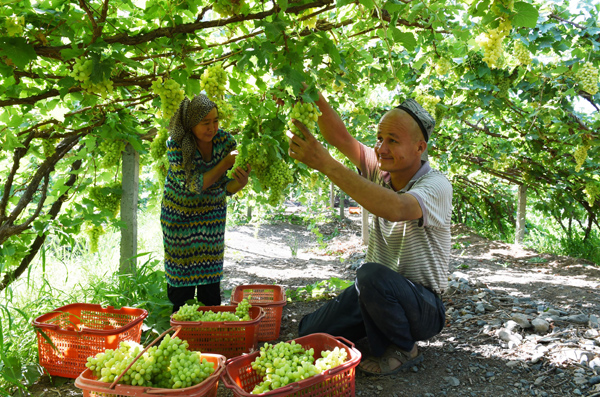 |
|
Farmers at a village in Turpan, the Xinjiang Uygur autonomous region, pick grapes in July. Turpan is one of China's main grape-producing regions. Liu Jian / For China Daily |
The established large corporations have realized that, as Chinese customers acquire more knowledge, they tend to favor wines that have unique personalities rather than those that come from giant production plants.
Meanwhile, many small wineries that were built five or six years ago have started to produce fine wines, and their number has been growing.
"They hold the key to the future of China's wine industry," Duan added
Silver Heights, a winery in the Ningxia Hui autonomous region, comes highly recommended by international wine masters such as Jancis Robinson and Robert Parker.
Its founder, Gao Lin, built the concrete-walled cellar at Silver Heights' first vineyard himself.
It lacks modern ventilation or dehumidification equipment. But this is where Gao, along with his 37-year-old daughter, Emma Gao, a winemaker who graduated from Bordeaux University's Institute of Oenology, and his son-in-law, Thierry Courtade - also a winemaker at Bordeaux's Chateau Calon-Segur - have produced wine since 2007.
"People don't care about how good your cellar looks, they actually visit you to find how good your wines are," said Gao.
"We started like a 'garage cellar', small in plantation and production scale, but producing delicate and top-quality wines."
Silver Heights has thrived on that philosophy, building up its brand and winning international awards. Spanish distributor Torres China supplies its products to 82 luxurious hotels and five-star Aman resorts in China, alongside grands crus such as 1982 Chateau Lafite. Silver Heights now tends 40 hectares of vines.
Yet this success story is just one of many that the Helan Mountain East Valley, an ambitious wine region protected by State certification of origin, has to offer the world.
Situated at latitude 38 degrees north, the region's average elevation is 1,100 meters above sea level. It enjoys 3,000 hours of sunshine yearly and has low rainfall of about 600 mm during the growing season.
The Yellow River has washed through the Helanshan Mountain region for millions of years, bringing rich minerals and porous gray desert soil.
This favorable terroir - the French term for an area's special characteristics - produces good grapes that have low vulnerability to disease. The resulting wines have won more than 100 international prizes, and the region has been accepted as an observer by the International Organization of Vine and Wine.
According to Cao Kailong, the director of the Ningxia Grape and Flower Industries Development Bureau, the region will be harvesting more than 70,000 hectares of grapes by 2020.
"There are already 100 established wineries, and another 100 wineries have completed or are now going through the registration process," said Cao.
